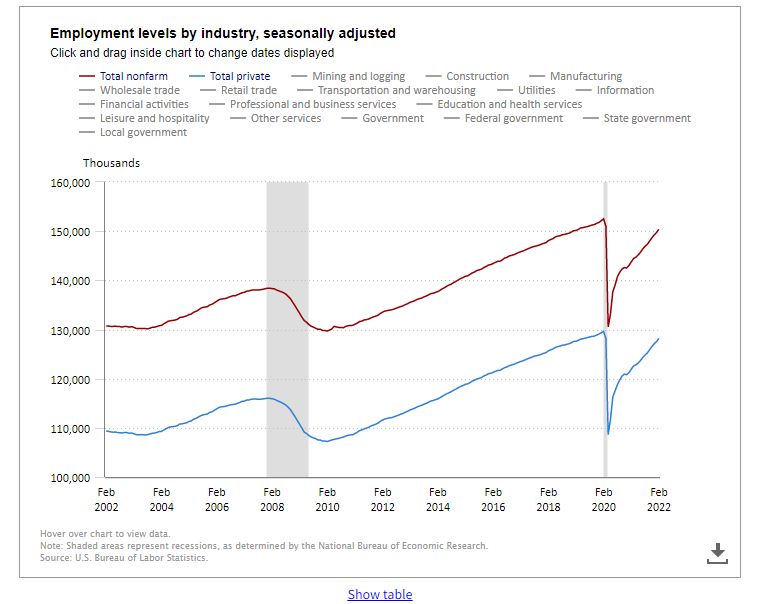Employment Blog March 2022
This Employment Blog is taken from the U S Department of Labor, Bureau of Labor Statistics. Nonfarm payroll employment rose by 678,000 in February, and the unemployment rate edged down to 3.8 percent. Employment growth was widespread, led by gains in leisure and hospitality, professional and business services, health care, and construction. Employment is down by 2.1 million, or 1.4 percent, from its level before the onset of the coronavirus (COVID-19) pandemic in February 2020.


In February, employment growth continued in leisure and hospitality (+179,000) with job gains in food services and drinking places (+124,000) and accommodation (+28,000). Employment in leisure and hospitality is down by 1.5 million, or 9.0 percent, from its February 2020 level.
Employment rose by 95,000 in professional and business services in February. Over the month, job gains occurred in temporary help services (+36,000), management of companies and 2 enterprises (+12,000), management and technical consulting services (+10,000), and scientific research and development services (+8,000). Employment in professional and business services is 596,000 higher than in February 2020, largely in temporary help services (+240,000), computer systems design and related services (+154,000), and management and technical consulting services (+152,000).
Health care added 64,000 jobs in February. Employment increased in home health care services (+20,000), offices of physicians (+15,000), and offices of other health practitioners (+12,000). Health care employment is 306,000 below its February 2020 level.
Construction employment rose by 60,000 in February, following little change in January. Job growth was concentrated in specialty trade contractors (+44,000), with both the residential (+24,000) and nonresidential (+20,000) components contributing to the gain. Construction employment is slightly below (-11,000) its February 2020 level.
In February, job growth continued in transportation and warehousing (+48,000). Employment increased in warehousing and storage (+11,000), couriers and messengers (+9,000), support activities for transportation (+9,000), and air transportation (+7,000). Employment in transportation and warehousing is 584,000 above its February 2020 level, with particularly strong growth in warehousing and storage (+420,000) and couriers and messengers (+240,000).
Retail trade added 37,000 jobs in February. Employment rose in building material and garden supply stores (+12,000), furniture and home furnishings stores (+6,000), and gasoline stations (+5,000). Retail trade employment is 104,000 higher than in February 2020.
In February, manufacturing added 36,000 jobs. Employment rose by 20,000 in durable goods industries. Job gains occurred in fabricated metal products (+11,000), machinery (+8,000), electrical equipment and appliances (+4,000), nonmetallic mineral products (+3,000), furniture and related products (+3,000), and primary metals (+3,000). These gains were partially offset by a job loss in motor vehicles and parts (-18,000). Nondurable goods manufacturing also added jobs in February (+16,000). Manufacturing employment is down by 178,000 from its February 2020 level.
Employment in financial activities grew by 35,000 in February, with job gains of 16,000 each in finance and insurance and in real estate. Employment in financial activities is 31,000 higher than its February 2020 level.
Social assistance added 31,000 jobs in February, with two thirds of the gain occurring in individual and family services 4 (+21,000). Employment in social assistance is down by 152,000 since February 2020.
Employment in the other services industry rose by 25,000 in February, with a job gain in repair and maintenance (+10,000). Employment in the other services industry is 317,000, or 5.3 percent, below its February 2020 level.
Wholesale trade added 18,000 jobs in February, but employment in the industry is down by 113,000 since February 2020.
Employment in mining increased by 9,000 in February, with job gains in support activities for mining (+6,000) and oil and gas extraction (+2,000). Since a recent low in February 2021, mining employment has grown by 62,000.
In February, employment showed little or no change in information and government.
Real average hourly earnings for all employees decreased 0.8 percent from January to February, seasonally adjusted, the U.S. Bureau of Labor Statistics reported today. This result stems from essentially no change in average hourly earnings combined with an increase of 0.8 percent in the Consumer Price Index for All Urban Consumers (CPI-U).Real average weekly earnings decreased 0.5 percent over the month due to the change in real average hourly earnings combined with an increase of 0.3 percent in the average workweek. Real average hourly earnings decreased 2.6 percent, seasonally adjusted, from February 2021 to February 2022. The change in real average hourly earnings combined with an increase of 0.3 percent in the average workweek resulted in a 2.3-percent decrease in real average weekly earnings over this period.
